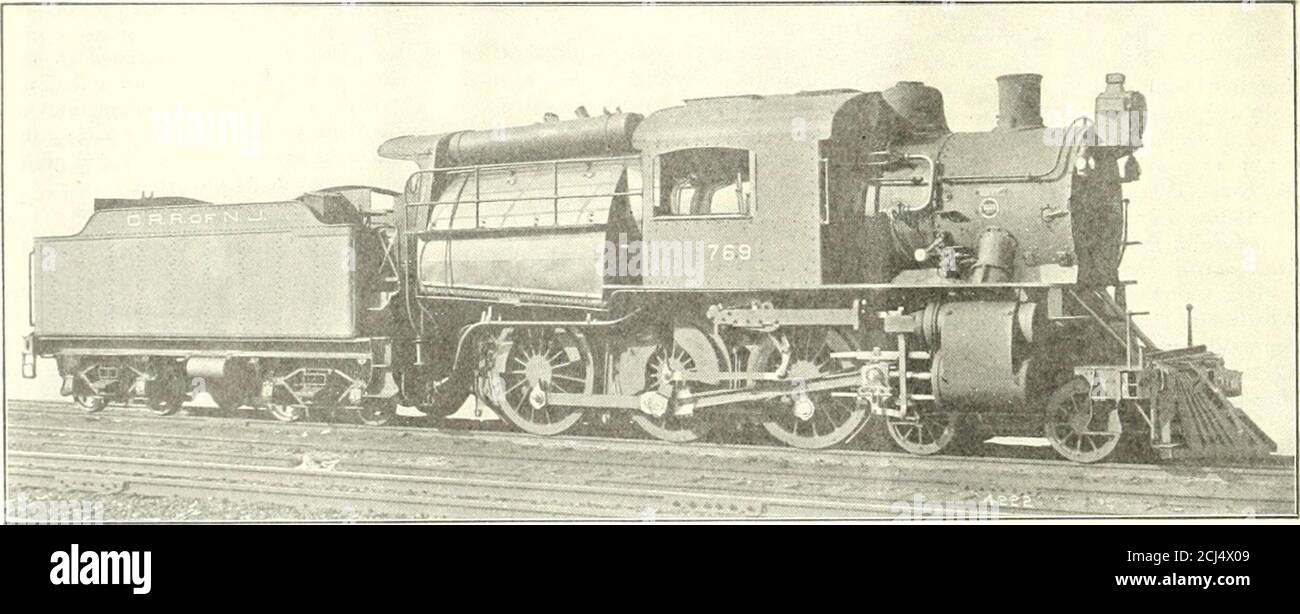. Railway and Locomotive Engineering . ead. The throat is necessarily shal-low, and the D-head protects the tubeends from extreme changes of tempera-ture. The forward end of the fireboxcrown is supported by three rows ofexpansion stays, and flexible stay-boltsare freely used, as 883 are distributedin the sides, throat and back-head. The steam distribution is controlledby 13-in. piston valves which are drivenby Walschaerts gear and are set with alead of Vi, in. As these locomotiveswill be used chieflv on level districts working pressure, 200 lbs.; fuel, fineanthracite; staying. Radial. Firebox—

Image details
Contributor:
Reading Room 2020 / Alamy Stock PhotoImage ID:
2CJ4X09File size:
7.1 MB (342.8 KB Compressed download)Releases:
Model - no | Property - noDo I need a release?Dimensions:
2488 x 1004 px | 21.1 x 8.5 cm | 8.3 x 3.3 inches | 300dpiMore information:
This image is a public domain image, which means either that copyright has expired in the image or the copyright holder has waived their copyright. Alamy charges you a fee for access to the high resolution copy of the image.
This image could have imperfections as it’s either historical or reportage.
. Railway and Locomotive Engineering . ead. The throat is necessarily shal-low, and the D-head protects the tubeends from extreme changes of tempera-ture. The forward end of the fireboxcrown is supported by three rows ofexpansion stays, and flexible stay-boltsare freely used, as 883 are distributedin the sides, throat and back-head. The steam distribution is controlledby 13-in. piston valves which are drivenby Walschaerts gear and are set with alead of Vi, in. As these locomotiveswill be used chieflv on level districts working pressure, 200 lbs.; fuel, fineanthracite; staying. Radial. Firebox—-Material, steel; length, 122/8 ins.; width, 964 ins.; depth, frontsMVz ins.; depth, back, 52Vi ins.; thick-ness of sheets: sides, % ins.; back, %ins.; crown, Ys ins.; tube, % ins. Water Space—Front, 4 ins.; sides, 4ins.; back, 4 ins.Tubes— Material Iron Iron Thickness No. 9W.G. No. 12 W.G.Number 30 210 Diameter Sls ins. 2 ins. Length 13ft. 10%in. 13ft. lOAin. Heating Surface—Firebox, 190 sq.ft.; combustion chamber, 19 sq. ft.;. W IIEKI. 4-0-U TVlK i;. E. CJiamlK )CUM I! I l-_ K.XTKAI. UAII.k IAD OF NEW JERSKY. Works, Duilde wheels avoided without materially re-ducing the steaming capacity of thelocomotive. F(ir this reason the ten-wheeled t3pe is proving efficient inhigh-duty service, both freight andpassenger, on the anthracite roads. The Central Railroad of New Jerseyhas recently receicd from The Bald-win Locomotive Works, ten Incoiiio-tives of the 4-6-0 type which are ex-cellent examples of a design suitablefor either freight or i>assengcr service.These engines burn fine anthracite andliave boilers of the modified Woottentype. The driving wheels are 69 ins.in diameter, thus giving them goodspeed capacity; and with a tractiveforce of 36, .S00 lbs. they are capa-t)Ie of handling heay trains. They areequipped with Schmidt superheatersand outside steam pipes. The grate is composed of water-tulies and rocking bars, and has an areaof SI.6 sq. ft. Firing is accomplishe